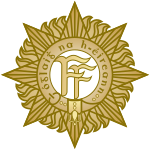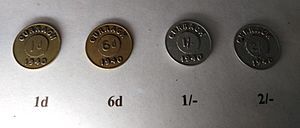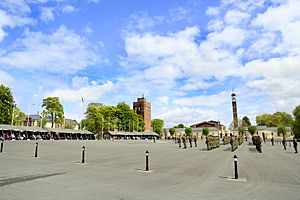Curragh Camp facts for kids
Quick facts for kids Curragh Camp |
|
|---|---|
| Campa an Churraigh | |
| The Curragh, County Kildare | |
 |
|
| Type | Military installation, education & training centre |
| Site information | |
| Controlled by | Irish Defence Forces/Department of Defence |
| Site history | |
| Built | 1855 |
| In use | 17th century – present |
| Garrison information | |
| Garrison |
|
The Curragh Camp (Irish: Campa an Churraigh) is a famous army base and military college located in The Curragh, County Kildare, Ireland. It is the main training centre for the Irish Defence Forces, which is Ireland's army. About 2,000 military members live and train here.
Contents
- The Curragh Camp: A Military History
- See also
- Images for kids
The Curragh Camp: A Military History
Why is the Curragh a Special Military Place?
The Curragh has always been a key spot for armies to gather. This is because it's a huge, flat area. As far back as 1599, someone named Henry Harvey said it was the best place he had ever seen to set up an army.
But the Curragh's history goes back even further! Ancient Irish stories, like the Annals of the Four Masters, mention that an Irish king named Lóegaire Lorc was killed there.
Later, in 1783, a huge event took place. Over 50,000 people came to watch the Irish Volunteers train. These volunteers were helping to defend Ireland while Great Britain was fighting in the American War of Independence.
The Curragh was also a gathering point during the 1798 Rebellion, a big uprising in Ireland. It's even mentioned in an old Irish folk song called The Sean-Bhean bhocht.
How the Curragh Camp Was Built
For a long time, armies used the Curragh for temporary training camps. For example, during the Napoleonic Wars, soldiers trained there to defend the UK.
However, the first permanent buildings at the Curragh were built in 1855. British soldiers from the Corps of Royal Engineers designed and constructed them. This happened during the Crimean War.
These first buildings were mostly made of wood. But the camp was quite large! It had its own post office, a fire station, ten barracks (where soldiers live), two churches, a water pumping station, a court house, and even a clock tower. It was built to hold about 10,000 soldiers.
Royal Visits and Camp Life in the 1800s
In 1861, Queen Victoria and Prince Albert visited the Curragh Camp. They came to inspect the troops, and their son, Edward VII (who was then the Prince of Wales), was serving there! A huge parade was held for their visit.
The first "modern" barracks, called Beresford Barracks, was built in 1879. Over the next few years, six more new barracks were added. These were named Ponsonby, Stewart, A.S.C., Engineer, Gough, and Keane Barracks.
Life at the Curragh Camp was well-organized. Soldiers had recreational facilities, including hunting for officers. Mail was delivered several times a day, and there was a daily Mass for Catholic soldiers. A gun was fired three times a day: in the morning, at 1 pm, and at 9:30 pm.
The Curragh Cemetery
The Curragh Cemetery is a special place with many graves. These graves show that the British Army was present at the Curragh until they left in 1922. The Commonwealth War Graves Commission looks after the graves of 104 soldiers who died at the camp during World War I. These graves are spread throughout the cemetery.
The Camp Changes Hands: 1922
In 1914, before the Anglo-Irish War, the Curragh Camp was involved in an event called the Curragh incident. Some British officers threatened to resign rather than enforce a new law called the Home Rule Act.
After the Anglo-Irish War (1919-1921), the British Army handed over the Curragh Camp to the new Irish Free State Army. This happened on May 16, 1922.
At 10 o'clock that morning, the camp was given to a group of Irish troops led by Lieutenant General O'Connell. The night before, the British flag (the Union Jack) was lowered for the last time. At noon on handover day, O'Connell climbed the water tower and raised the first Irish tricolour flag over the Curragh Camp.
It was a tradition for the British Army to cut down the flagpole when they left a base. So, the Irish officers had to physically hold up the flagpole while the tricolour was raised! Both the old British flag and the new Irish flag, which are very large (about 10 by 18 feet), are now kept safe at the Defence Forces Training Centre (DFTC).
Internment at the Curragh: A Place of Detention
The Curragh Camp was used to hold people in different times of conflict.
During the Irish Civil War (1922-1923)
During the Irish Civil War, the new Irish government used the Curragh to hold people who were against the Anglo-Irish Treaty. The main internment camp there was called Rath camp. It held 1,300 people in 60 wooden army huts. The area was surrounded by tall fences and had machine gun towers.
Many people tried to escape from the Curragh by digging tunnels. In April 1921, a tunnel was found, and the prisoners lost some of their privileges. On July 11, 1921, the Irish War of Independence ended, and all tunneling stopped for a while.
However, some escapes still happened. On September 9, 1921, between 50 and 70 men escaped from Hare Park camp at the Curragh. They used a tunnel that took over a month to dig with only knives and spoons! They waited for a foggy night and used the noise from a concert to cover their escape. None of these escapees were ever caught.
Executions and Deaths During the Civil War
In December 1922, seven men were executed at the Curragh Military Prison. They were accused of attacking railways and shops. A memorial to these men can be found in Kildare Town.
During the Civil War, some prisoners also died in custody at the Curragh. There were also hunger strikes by Irish Republican prisoners. They were protesting being held without charges and poor prison conditions. The strike spread to the Curragh, where 3,390 prisoners joined. Sadly, four prisoners died at the Curragh as a result of these hunger strikes.
Internment During "The Emergency" (World War II)
During The Emergency (which is what Ireland called World War II), Irish Republicans were again held at the Curragh. Many IRA members were arrested and sent there. The camp was often called Tin Town by the prisoners. It's believed that about 2,000 IRA members were held there during the war years.
The Curragh also held Allied and Axis soldiers and airmen who ended up in Ireland during World War II. There were separate sections for IRA members, Allied airmen, and German airmen and sailors. These "internees" were not strictly locked up and were sometimes allowed to attend social events outside the camp. A movie called "The Brylcreem Boys" was made in 1998 about the World War II detention camp.
Internment During the Border Campaign (1956-1962)
The Curragh Internment Camp also held members of the Irish Republican Army (IRA) during their Border Campaign from 1956 to 1962. On December 2, 1958, 14 prisoners escaped from the camp. The camp held about 150 men at that time. The last prisoners were released, and the internment camp closed on March 11, 1959.
The Modern Curragh Camp Today
Today, the Curragh Camp is home to the Defence Forces Training Centre (DFTC) of the Irish Defence Forces. This is where many important military schools and units are located, including:
- The Command and Staff School
- The Cadet School (for future officers)
- The Infantry School
- The Combat Support College
- The Combat Services Support College
- The Equitation School (for horse riding training)
- A logistics base
- A supply and services unit
- The United Nations School (for peacekeeping training)
The Curragh Camp has been updated a lot in recent years. Soldier living quarters have been renovated, and dining facilities have been improved. There's also a new workshop complex and a large garage for military vehicles like the MOWAG Piranha APCs.
The tallest building at the Curragh is the fire station, where the army keeps a modern fire fighting service ready.
See also
- Curragh incident
- Defence Forces Training Centre (DFTC)
- List of Irish military installations
Images for kids





